Late Lammas Reflections
Sea Stars – Illuminating the potential for regeneration
Marie Edwards
As we move beyond the first of our seasonal harvest celebrations; Lammas, we may wish to reflect somewhat on the more active part of the year which lies behind us. It seems that we are collectively becoming increasingly aware of the devastating impact that our dominant culture is having on our fellow life forms, particularly our insect population. I recall that as a child, just before we experienced stormy weather, I would be covered in thrips also known as thunderbugs. Now I am almost ecstatic if I catch a glimpse of one of them. There may be less thunderbugs left to warn us, but it does appear that due to the real and tragic degradation of our biosphere the turbulence of stormy times may be before us.
In late Summer we might be spending time increasingly out of doors to delight in the fullness of life that is all around us. If we have an opportunity to go rock pooling, we can fortunately still experience the pleasure of exploring our shoreline ecosystems. We may even have the joy of stumbling upon the wisdom of Starfish also known as Sea Stars. Some say that starfish are; “the stars that fell from the sky into the ocean”, inherently reminding us of our connection to the stars and greater cosmos. At this intense time of planetary initiation, we might wonder what our relationship with the stars and star nations could be. Given the recent US Navy revelations with regards to UFO’s, now officially referred to as UAP’s, we may contemplate if there is more to these stories than we have previously been open to…
We could consider that as a species we are called to ”reach for the stars” as the immense need for healing that is required in our world might appear to be in the realms of the seemingly impossible. Extraordinary times require astonishing medicines which may be what the starfish in our waters are urging us to see. Sea stars are able to hold their position in the most tumultuous of currents and can move with careful consideration and grace to wherever they need to be. Starfish are not fazed by the power of the ocean or perhaps metaphorically, the strength of emotions. They can be fully immersed in treacherous seas without being consumed or swept away, unless they choose to surrender, let go and immerse themselves in the flow. Starfish can thrive in both deep and shallow waters in the hottest and coldest of conditions. A powerful demonstration of both resilience and adaptability.
They have a great sensitivity to their environments and a level of agility and strength which means that they are able to manoeuvre within their surroundings with a high degree of stealth. With their tenacity and determination sea stars can grasp opportunities, sourcing their power from within, as if having implicit trust in their inner guidance or intuition. Perhaps most incredible, is the starfish’s ability to regenerate and renew itself. A few species of starfish have the ability to completely recover from the loss of all their limbs bar one, which to me is utterly mind-blowing. They remind us that the answers and healing that we need lies deep inside each of us. Sea stars demonstrate that we can return to "wholeness". Starfish are also able to communicate with members of their own species by releasing specific chemicals exhibiting phenomenal sensory capabilities and collective awareness. Are starfish somehow able to experience the whole picture and therefore simply know how ‘to be’ just as they are in the moment?
According to fossil records, our ancient sea star relatives originated in the Ordovician period around 450 million years ago. They are far more ancient than we are, yet we would have had a relationship with these life forms thousands of years ago when we lived as hunter gatherers on the land. In fact, some indigenous people include starfish as a minor part of their diet. They are also occasionally eaten in Japan, China and Micronesia.
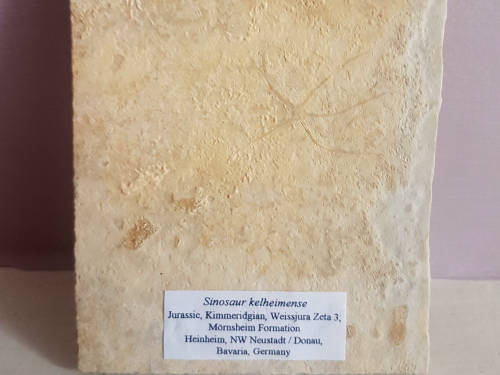 |
|---|
| Starfish - Sinosaur Kelheimense - Jurassic, Kimmeridgian, Bavaria |
 |
Starfish are one of the planet’s keystone species which means that their contribution to their ecosystem is particularly large despite the size of their population which is comparatively small. It has been proposed that we, human beings, may be a ‘hyper-keystone’ species. We are evidently capable of impacting all ecosystems and destroying life on Earth, however as permaculture design understands… within the ‘problem’ lies the solutions. We therefore may find that we have the potential to support the full regeneration of life on our planet. It is said that with great power comes great responsibility. Are we to become a parasitic force devouring all life here and on any other planets we may come across or are we to actualise our full creative potential working with the force of life to restore ecological balance and harmony?
Some say that Starfish are associated with the divine feminine and inspiration. Certainly, stars themselves often stir up a sense of wonderment that can open us up to what might truly be possible. As the stars above have guided our sailors at sea, so the sea stars of the ocean may aid us in navigating these times.
- Read more about starfish on Wikipedia
- Humans as a Hyperkeystone Species (PDF)
- "Climate: A New Story” by Charles Eisenstein
Be “InTune” with Nature
The Season of Summer and Late Summer
Krysia Soutar
Observing nature's patterns, summer is the time of activity and growth. In our temperate climate, we can observe how everything changes as we move from the uprising energy of spring to the more active and expansive energy phase of summer. In Nature, we can see how this phase of uprising and expansive energy creates upward and outward growth in the form of our plants and trees.
Nature's yearly cycle of movement and change
This summer we have observed a change in our weather patterns in the British Isles. We have had sudden very heavy rain, then very hot days. Our ecosystems are adapting and trying to maintain harmony in response to these changes. We, too, must respond by changing our way of life, which is currently out of touch with Nature, leading us into many difficulties.
We could say that we have lost our balance with Nature, and therefore we need to return to ways of living that do not harm natural ecosystems, and of course our own human physical, vibrational and spiritual being. One way to go is to create food systems and develop cooking skills which are healthy and support all life forms. We can become more wise in our use of natural resources.
If our summers are going to be hotter with heavy rain, we need to consider our long-term permaculture strategies for growing and planting our food within our local bioregions. We will stay in tune with Nature by using the food available to us.
Early Summer and the Five Transformations of Energy
Because it is the most expansive upward form of energy, this is known as the phase of ‘Fire Energy’.
The organs associated with the fire element are the heart and the small intestine. Much research is now available on the importance of keeping the small intestine microbiome healthy. Just like in the soil, we need to feed our healthy gut bacteria with the foods they need, usually vegetables and fermented foods. This will encourage the number of beneficial bacteria, which can improve your immune system, manufacture nutrients and make your gut healthier. If your gut is healthy you are more likely to be healthy too.
Foods which are generally supportive at this time of year include those with a bitter taste, also lighter and more raw food.
Late summer and the Five Transformations of energy
Later, the season changes into the phase of “Soil Energy”. This is a time to nourish and conserve the sweetness in your life! In late summer, we have moved from the high active energy phase of early summer, to the calmer descending energy phase. We can feel it as a quieter time, just before autumn. The organs associated with late summer are Spleen, Stomach Pancreas, and the Immune System.
Foods and cooking styles to support these functions are sweet tasting vegetables, those with a round shape such as pumpkin and onions. Roasted vegetables are good at this time of year. Whole grains, such as rice and millet provide a steady release of glucose, rather than the quick spike of blood glucose associated with white sugar. These foods support the blood sugar levels and keep the pancreas calm. If your blood sugar is balanced you feel grounded and calm, with an abundance of energy!
Recipe for Late Summer
Seasonal Berry and Fruit crumble with custard
(This recipe is also suitable for vegans).
Use a selection of fruits of your choice, from what you have locally. This time, I had wild apples, gooseberries and soft red plums.
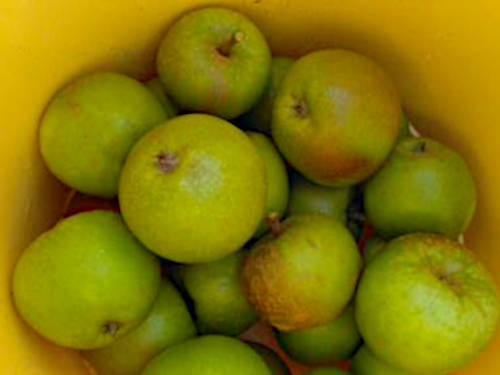 |
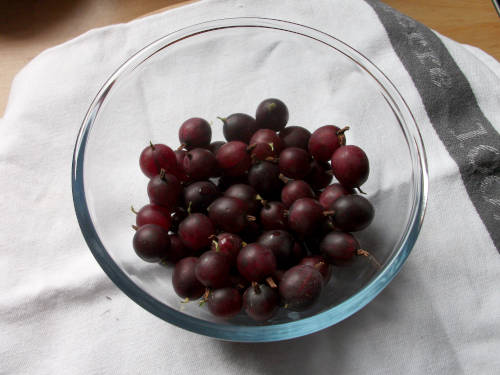 |
| Wild Apples | Worcester Berries |
- Peel core and slice apples
- Cover with cold water and pinch of natural sea salt
- Bring to simmer and wait until just soft
- Add a teaspoon of maple syrup or more according to taste
- Place cooked apples in pie dish
- Wash and slice plums
- Wash and remove stems and ruffs from the gooseberries
- Place plums and gooseberries in pan with enough water to cover
- Simmer gently for around 2 minutes, then remove and place in pie dish
- Cover with crumble and cook gently in oven at Gas Mark 3 (160C)for approx. 10 – 15mins
Crumble topping
- 2 cups of granola (ready made, naturally sweetened)
- 1 -2 teaspoon original hemp oil, good quality olive oil or light sesame oil
- Mix granola and oil together well, then layer over fruit
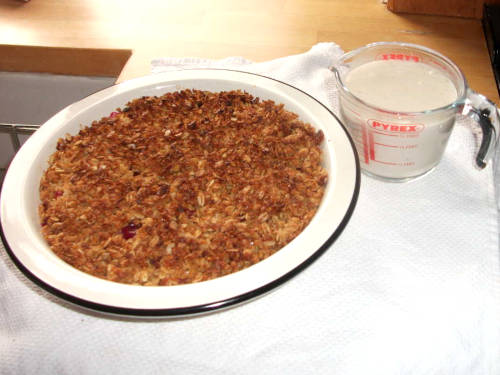 |
|---|
 |
Sauce
-
2 -4 cups of rice milk or oat milk
-
2 tablespoons of kuzu
-
Tablespoon of pure maple syrup (vary according to taste)
-
1 vanilla pod
-
Place milk in pan and heat
-
De-seed vanilla pod and add to milk simmer for 5-8mins
-
Dissolve kuzu in a little cold water until liquid
-
Add kuzu to milk and stir constantly for 3- 5 mins
-
Add maple syrup to custard to taste
‘Bon Appetit’
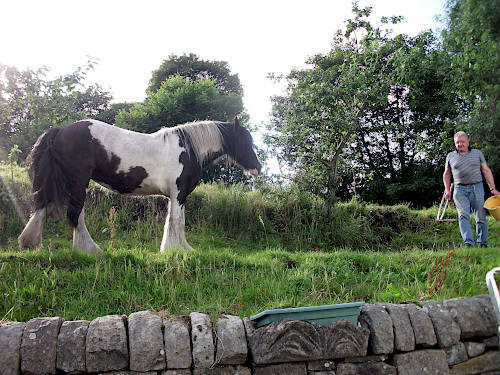 |
|---|
 |
Late summer Wild Medicine
Edwina Hodkinson
I love late summer. Long warmer days and abundant harvests of herbal medicine. As I look at my many jars of fresh herbal tinctures, infused oils, salves and drying herbs, I feel filled with gratitude for the medicine of Mother Earth. Our ancestors celebrated this with the festival of Lammas or Lughnasadh on the 1st /2nd of August, which was a time of harvest and thanksgiving for the abundance and bounty of the land.
Walk or drive alongside any road, lane or wasteland and there will be an abundance of tall Rosebay Willowherb spikes, energy-giving Nettle seeds and silvery Mugwort whispering of ancient magic and women’s wisdom. All so abundant and classed as just weeds, they are hardly noticed and their amazing medicine almost forgotten by many, apart from those connected to the wisdom of the land.
Rosebay Willowherb
Epilobium angustifolium (Fireweed)
This tall 1.5m perennial with stunning magenta flower spikes is a familiar sight in summer and can be found in parks, hedgerows, derelict ground, along railways. Ecologically it has a use in helping to repair and regenerate damaged, traumatised and burnt earth. After the second world war, it covered the bombsites, earning the name "Bomb weed".
Rosebay willowherb is a herb beloved by first nations people of Canada, Alaska and Siberia. And is a valuable food, medicine, fire lighting material, waterproofing for mittens, cordage, fibre and the fermented leaves, once imported to the UK from Russia were popular here as Kapoori or ‘Ivan’s’ tea before Indian and China tea became our national drink.
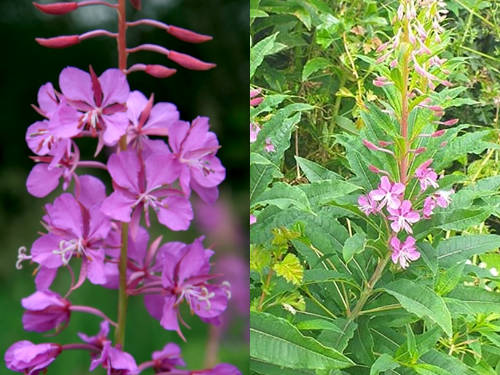 |
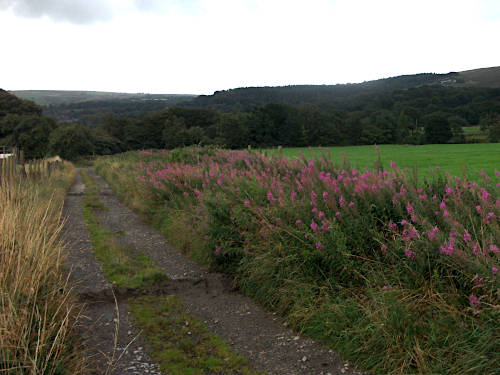 |
Rosebay Willowherb is full of vitamin A, C and with a plethora of antioxidants, it tastes like a nice quality green tea, looks prettier and is easy to make at home from the flowers and leaves. Rosebay Willowherb is also an excellent herb for the digestive tract with a history of use with infectious diarrhoea and was once a favourite herb in treating cholera, typhoid and dysentery. It's anti-microbial and astringent, with an anti-inflammatory effect on the bowel which makes it helpful at managing ulcerative colitis, diverticulitis, irritable bowel and gastric ulcers.
It has an antifungal action too and was effective against a wide range of fungus infections which include Candida albicans. It also has a pre-biotic effect that can help support normal gut flora. Native people use it to help with the "green diarrhoea" that comes with the transition from the winter diet of grain and meat to the summer diet of vegetables and fruit. I'm thinking of this time in our history when we have damage to our digestive tracts due to the damage of the human microbiome, not just the overuse of antibiotics, but from the glyphosates in our food and environment, sugar, mercury in fillings, processed foods, chlorinated water, etc. This can lead to an overgrowth of unhelpful gut bacteria, Candida being only one species that can be the root cause of not just digestive problems and allergies but many systemic problems too.
Apart from being good digestive medicine, it’s been used traditionally for an enlarged prostate gland, prostate cancer, heavy periods, asthma and whooping cough, and it has immuno-modulating properties too. When extracts of Rosebay Willowherb were studied in labs it was found to be effective against the flu virus, improving mortality and survival rates.
Fireweed is excellent too in skincare, being good in a salve for cuts, burns, rashes, acne, eczema and psoriasis and is used commercially in skincare products. Some studies show it has an anti-inflammatory effect on the skin which has been shown to be comparable with steroid creams.
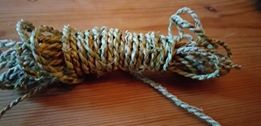 |
|---|
| Rosebay Willowherb Cordage |
 |
Mugwort
Artemesia vulgaris
Another amazing herb is Mugwort. It grows in abundance all over the North West and can be found alongside lanes, roads, the River Irwell, by town car parks and in great swathes alongside the M62 and M6 motorways.
To many people, this is our very own native magical and shamanic plant and is increasingly being used to make Mugwort smudge sticks rather than import Native American White Sage which although in the same family as Mugwort is now in danger from over-harvesting. In my own experience, it's the best thing for cleansing negative energy and bringing in positive energy to people and places as well as creating sacred space.
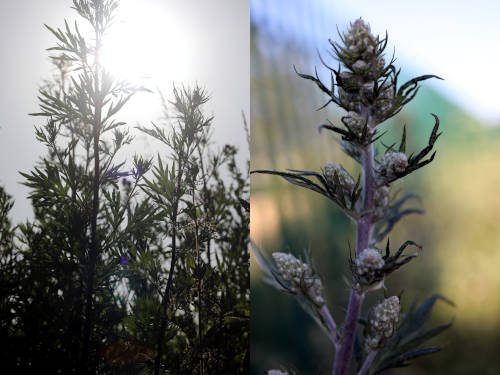 |
|---|
 |
I've been working with Mugwort for many years now in my Herbal practice. Mugwort is a really ancient herb that earned the name Una or the "Mother of all Herbs" because it was held in such high regard by our ancestors.
It’s a valuable, underused herb for women’s hormonal problems, earning the patronage of Artemis, the Greek goddess of women. Mugwort helps to regulate and normalise menstrual flow, bring on suppressed or delayed periods and helps to regulate cycles, especially for younger women. It’s good for very heavy, cramping, painful periods and helpful for migraines associated with menstrual cycles and pre-menstrual syndrome, especially if associated with mood changes and stress. One of my Herbalist friends used Mugwort to great effect for her teenage daughter's premenstrual migraines and found it was the only thing that worked for her. I sometimes use a Mugwort salve externally over the pelvis as an alternative to a tea. Mugwort is very stimulating to the uterus, increasing blood supply and removing stagnant blood as well as regulating hormone levels, so, for this reason, it’s not to be used in pregnancy.
I've used Mugwort for menopausal anxiety too as I feel it can help ease the challenges on the menopausal transition as well as being relaxing, it reminds all menopausal women of the value of their years and the magic and power that awaits us in the wise woman phase of our lives.
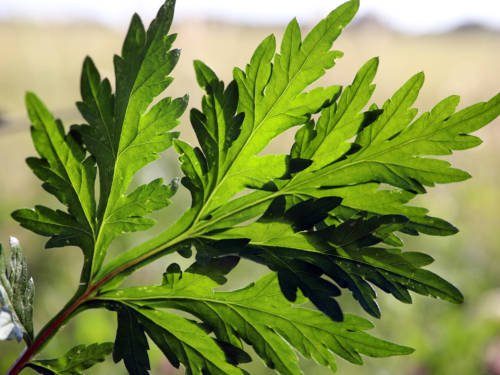 |
|---|
 |
Taste Mugwort tea and you will see that it’s very mildly bitter as well as being deliciously aromatic. It's good for stimulating and toning the digestive system, encouraging the secretion of digestive juices and improving liver function. Its aromatic oils are anti-spasmodic and it can help eliminate wind and soothe griping pains. It has a history of being used to expel parasites and worms from the digestive tract.
Mugwort is also very calming for the nervous system and very helpful for depression, anxiety and stress, especially if associated with hormonal imbalances. It has an uplifting effect on the mood, and some people like to smoke the buds and leaves as it's very mellow and relaxing to use.
Mugwort is well known for helping with lucid dreaming, but this doesn't suit everyone, so be aware this can happen when you use it.
I love to gather Mugwort in big bunches as soon as the buds appear and hang it to dry in my garage so that I can make smudge sticks that I use all year round. Sometimes I place it in vodka to tincture as well as triple infusing it in sunflower oil for use in a healing and very versatile salve. The tea whether using it fresh or dried is lovely. Just add about a teaspoon to a cup of water, infuse for 10 minutes and enjoy.
Mugwort salve
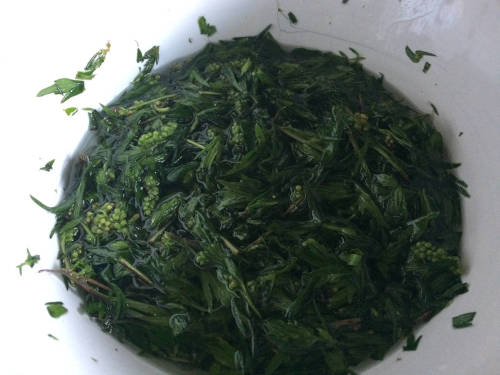 |
|---|
 |
- Harvest the Mugwort on a dry day. Chop and place it in a heatproof bowl and cover with sunflower oil.
- Place the bowl on top of a pan of boiling water. Bring to the boil and simmer. Cover the oil with a pan lid to keep in the essential oils.
- Simmer for 1-2 hours making sure the water doesn't boil dry.
- When the plant has given up all its medicine to the oil (the oil looks green and the plant material spent) strain, composting the used plant material.
- Re-infuse fresh Mugwort into the oil and repeat the process. I sometimes do it three times to really increase the potency.
- When the process is complete, take the deep green aromatic infused oil and leave to settle overnight so that any water or debris sinks to the bottom.
- Decant into a clean dry, sterilised bottle, Take care in pouring off to leave any sediment on the bottom.
To make a salve reheat with 10% beeswax or 13-15% carnauba wax (vegan) added to make into a salve. Put into sterilised jars allow to cool and label. Use within a year.
Great for aching, torn or pulled muscles, ligaments, and tendons, cramps, cuts, infections, bumps, bruises, contusions, insect bites and nerve pain, period pains, heavy periods, womb massage and for aching feet.
Nettle seeds
Once acquainted with them, people love nettle seeds and I can imagine our ancestors taking them fresh off the plant in late summer to nibble to give them a boost of energy to enable them to work the long summer evenings of bringing in the harvest, prepare and preserve the food that helped them survive the winter or when travelling.
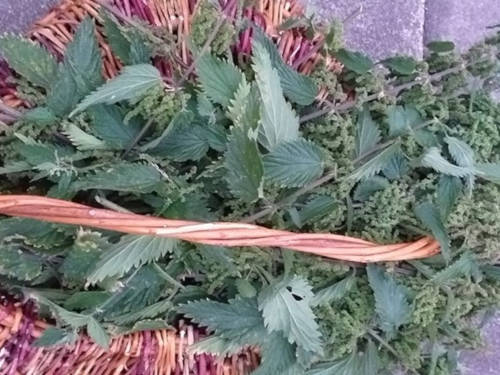 |
|---|
| A harvest of nettle seed |
 |
The seeds of the nettle are powerful adrenal tonics which help the body adapt to stress. They are a valuable aid in helping people to cope with exhaustion and fatigue. Fresh from the plant, they are very stimulating and can be used with nuts, cacao, dried fruits and coconut to make energy seed balls. Take too much (some say more than half a teaspoonful) and you are awake all night.
Dried, they help support and replenish the adrenal glands and kidneys helping to restore function when damaged by drugs or diabetes. They have also a traditional use as an aphrodisiac. Take 1-2 teaspoons of dried seeds per day to restore kidney function and libido.
Edwina Hodkinson BSc(Hons) is a qualified medical herbalist and is a member of the National Institute of Herbal Medicine (MIMH)
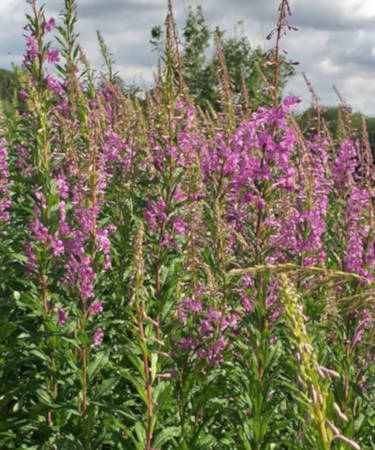 |
|---|
 |